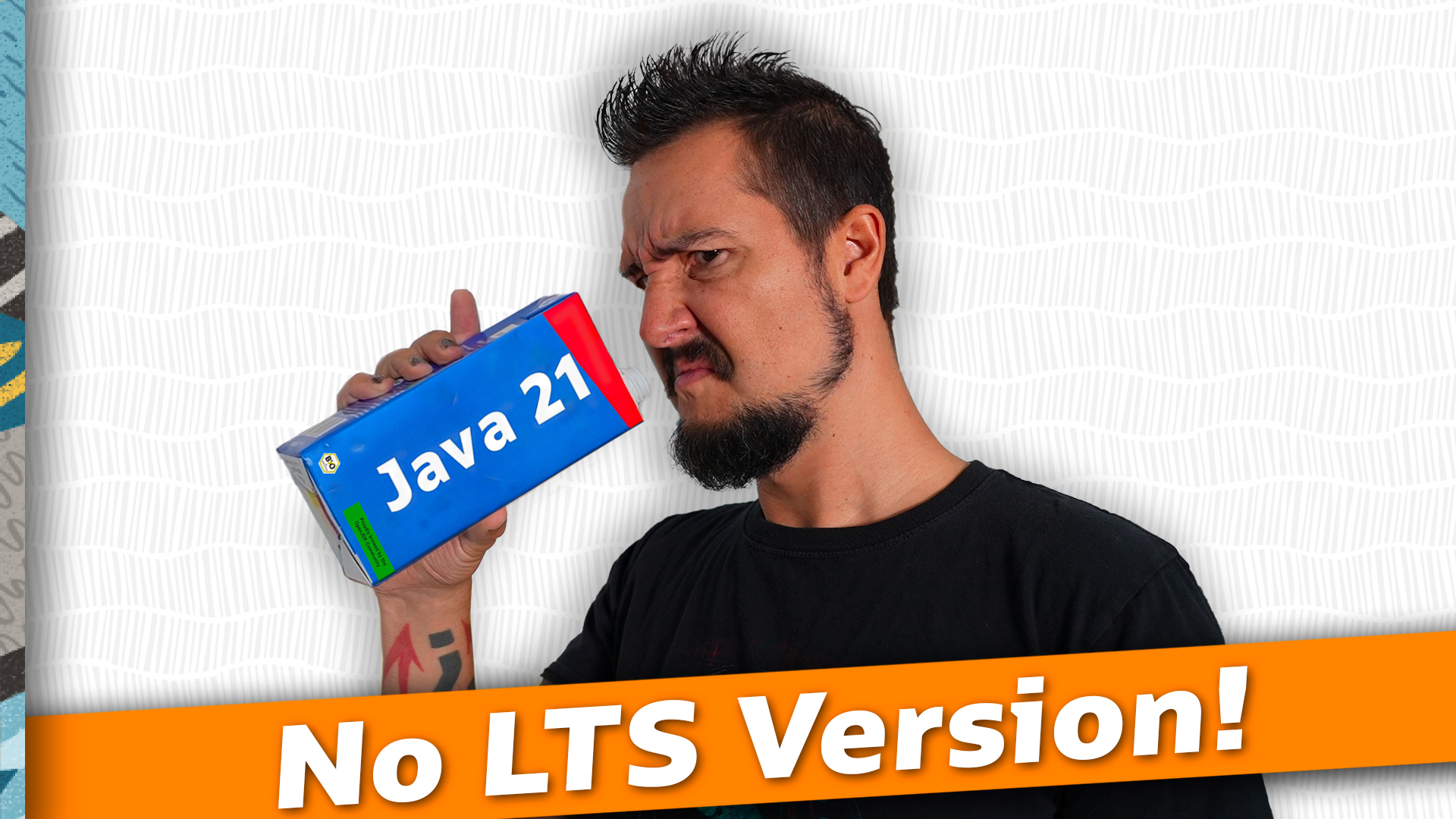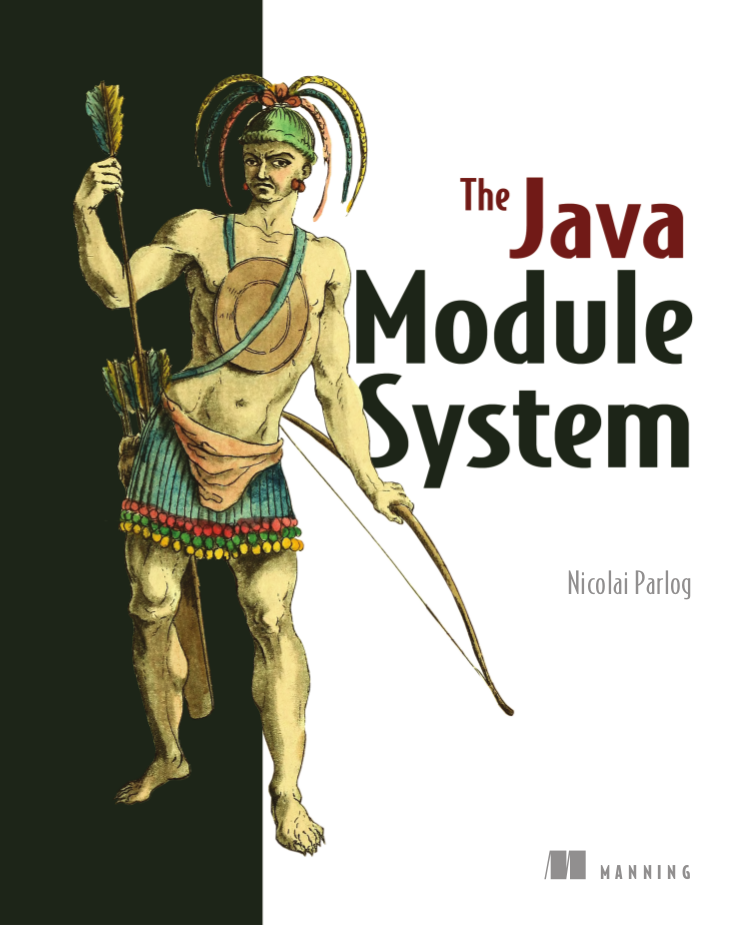public sealed interface Page
permits GitHubIssuePage, GitHubPrPage,
ExternalPage, ErrorPage {
// ...
}Java 21 💣💥
Accento 2023
Karlsruhe
October 24th, 25th
50% discount: AccJUGKA23
I have two free tickets!
Let’s get started!
this talk covers Java 21
this is a showcase, not a tutorial
slides at slides.nipafx.dev/java-x
(hit "?" to get navigation help)
Lots to talk about!
| Pattern Matching |
| Data-Oriented Programming |
| Virtual Threads |
| Preparing For Virtual Threads |
| String Templates |
| Sequenced Collections |
| On-Ramp |
| GenZGC |
Why upgrade?
Costs of running on old versions:
support contract for Java
waning support in libraries / frameworks
Why upgrade?
Costs of not running on new versions:
lower productivity
less observability and performance
(more on that later)less access to talent
bigger upgrade costs
Why upgrade?
Resistence is futile.
How to upgrade?
Preparations:
stick to supported APIs
stick to standardized behavior
stick to well-maintained projects
keep dependencies and tools up to date
stay ahead of removals (
jdeprscan)build on many JDK versions
How to upgrade?
Prepare by building on multiple JDK versions:
your baseline version
every supported version since then
latest version
EA build of next version
How to upgrade?
It’s not necessary to build …
… each commit on all versions
… the whole project on all versions
Build as much as feasible.
What about LTS?
Within OpenJDK, there is no LTS.
⇝ has no impact on features, reliability, etc.
It’s a vendor-centric concept
to offer continuous fixes
(usually for money).
You’re paying not to get new features.
What about LTS?
Java 21 💣💥
| Pattern Matching |
| Data-Oriented Programming |
| Virtual Threads |
| Preparing For Virtual Threads |
| String Templates |
| Sequenced Collections |
| On-Ramp |
| GenZGC |
A simple app
Features:
scrapes GitHub projects
creates
Pageinstances:GitHubIssuePageGitHubPrPageExternalPageErrorPage
further processes pages
A simple app
Features:
display as interactive graph
compute graph properties
categorize pages by topic
analyze mood of interactions
process payment for analyses
etc.
A simple architecture?
How to implement features?
methods on
Page😧visitor pattern 😫
pattern matching 🥳
Pattern Matching
Sealed Page
Sealed types limit inheritance,
by only allowing specific subtypes.
Switch over Page
public void categorize(Page page) {
switch (page) {
case GitHubIssuePage issue
-> categorizeIssue(issue);
case GitHubPrPage pr
-> categorizePr(pr);
case ExternalPage external
-> categorizeExternal(external);
case ErrorPage error
-> categorizeError(error);
}
}Maintainability
Unlike an if-else-if-chain,
a pattern switch needs to be exhaustive.
Fulfilled by:
switching over a sealed types
a
caseper subtypeavoiding the
defaultbranch
⇝ Adding a new subtype causes compile error!
Dynamic dispatch
Dynamic dispatch selects the invoked method by type.
As language feature:
via inheritance
makes method part of API
What if methods shouldn’t be part of the API?
Dynamic dispatch
Without methods becoming part of the API.
Via visitor pattern:
makes "visitation" part of API
cumbersome and indirect
Via pattern matching (new):
makes "sealed" part of type
straight-forward
More
More on pattern matching:
Java 21 💣💥
| Pattern Matching |
| Data-Oriented Programming |
| Virtual Threads |
| Preparing For Virtual Threads |
| String Templates |
| Sequenced Collections |
| On-Ramp |
| GenZGC |
Data-Oriented Programming
Use Java’s strong typing to model data as data:
use types to model data, particularly:
data as data with records
alternatives with sealed types
use (static) methods to model behavior, particularly:
exhaustive
switchwithoutdefaultpattern matching to destructure polymorphic data
Data-Oriented Programming…
- … isn’t funtional programming
but it’s similar (data + functions)
first priority is data, not functions
- … doesn’t kill object-oriented programming
use OOP to modularize large systems
use DOP to model small, data-focused (sub)systems
More
More on data-oriented programming:
📝 Data Oriented Programming in Java (Brian Goetz on InfoQ)
🎥 Java21 Brings Full Pattern Matching (Sep 2023)
🧑💻 GitHub crawler
Java 21 💣💥
| Pattern Matching |
| Data-Oriented Programming |
| Virtual Threads |
| Preparing For Virtual Threads |
| String Templates |
| Sequenced Collections |
| On-Ramp |
| GenZGC |
A simple web request
Imagine a hypothetical HTTP request:
interpret request
query database (blocks)
process data for response
Resource utilization:
good for 1. and 3.
really bad for 2.
How to implement that request?
Synchronous
Align application’s unit of concurrency (request)
with Java’s unit of concurrency (thread):
use thread per request
simple to write, debug, profile
blocks threads on certain calls
limited number of platform threads
⇝ bad resource utilization
⇝ low throughput
Asynchronous
Only use threads for actual computations:
use non-blocking APIs (futures / reactive streams)
harder to write, challenging to debug/profile
incompatible with synchronous code
shares platform threads
⇝ great resource utilization
⇝ high throughput
Conflict!
There’s a conflict between:
simplicity
throughput
Nota Bene
There are other conflicts:
design vs performance (⇝ Valhalla)
explicitness vs succinctness (⇝ Amber)
flexibility vs safety (⇝ Panama)
optimization vs specification (⇝ Leyden)
Enter virtual threads!
A virtual thread:
is a regular
Threadlow memory footprint ([k]bytes)
small switching cost
scheduled by the Java runtime
requires no OS thread when waiting
Virtual things
Virtual memory:
maps large virtual address space
to limited physical memorygives illusion of plentiful memory
Virtual threads:
map large number of virtual threads
to a small number of OS threadsgive the illusion of plentiful threads
Virtual things
Programs rarely care about virtual vs physical memory.
Programs need rarely care about virtual vs platform thread.
Instead:
write straightforward (blocking) code
runtime shares available OS threads
reduces the cost of blocking to near zero
Example
try (var executor = Executors
.newVirtualThreadPerTaskExecutor()) {
IntStream
.range(0, 1_000_000)
.forEach(number -> {
executor.submit(() -> {
Thread.sleep(Duration.ofSeconds(1));
return number;
});
});
} // executor.close() is called implicitly, and waitsEffects
Virtual threads:
remove "number of threads" as bottleneck
match app’s unit of concurrency to Java’s
⇝ simplicity && throughput
Performance
Virtual threads aren’t "faster threads":
same number of CPU cycles
each task takes the same time (same latency)
So why bother?
Parallelism vs concurrency
| Parallelism | Concurrency | |
|---|---|---|
Task origin | solution | problem |
Control | developer | environment |
Resource use | coordinated | competitive |
Metric | latency | throughput |
Abstraction | CPU cores | tasks |
# of threads | # of cores | # of tasks |
Performance
When workload is not CPU-bound:
start waiting as early as possible
for as many tasks as possible
⇝ Virtual threads increase throughput:
when workload is not CPU-bound
when number of concurrent tasks is high
Server How-To
For servers:
request handling threads are started by web framework
frameworks will offer (easy) configuration options
We’re not there yet.
Spring Boot
Replace executors:
@Bean
public TomcatProtocolHandlerCustomizer<?>
createExecutorForSyncCalls() {
return handler -> handler.setExecutor(
Executors.newVirtualThreadPerTaskExecutor());
}
@Bean
public AsyncTaskExecutor
createExecutorForAsyncCalls() {
return new TaskExecutorAdapter(
Executors.newVirtualThreadPerTaskExecutor());
}Quarkus
Annotate request handling method:
@GET
@Path("api")
@RunOnVirtualThread
public String handle() {
// ...
}(Requires --add-opens java.base/java.lang=ALL-UNNAMED.)
More
Virtual Threads
Go forth and multiply (your threads)
Java 21 💣💥
| Pattern Matching |
| Data-Oriented Programming |
| Virtual Threads |
| Preparing For Virtual Threads |
| String Templates |
| Sequenced Collections |
| On-Ramp |
| GenZGC |
Preparing your code
Virtual threads:
always work correctly
may not scale perfectly
Code changes can improve scalability
(and maintainability, debuggability, observability).
Avoid thread pools
Only pool expensive resources
but virtual threads are cheap.
⇝ Replace thread pools (for concurrency),
with virtual threads plus, e.g., semaphores.
With thread pools
// limits concurrent queries but pools 👎🏾
private static final ExecutorService DB_POOL =
Executors.newFixedThreadPool(16);
public <T> Future<T> queryDatabase(Callable<T> query) {
return DB_POOL.submit(query);
}With semaphore
// limits concurrent queries without pool 👍🏾
private static final Semaphore DB_SEMAPHORE =
new Semaphore(16);
public <T> T queryDatabase(Callable<T> query)
throws Exception {
DB_SEMAPHORE.acquire();
try {
return query.call();
} finally {
DB_SEMAPHORE.release();
}
}Where are the virtual threads? ⇝ Later.
Caveats
To understand virtual thread caveats
we need to understand how they work.
(Also, it’s very interesting.)
Under the hood
The Java runtime manages virtual threads:
runs them on a pool of carrier threads
on blocking call:
internally calls non-blocking operation
unmounts from carrier thread!
when call returns:
mounts to (other) carrier thread
continues
Stack chunks
A virtual thread stack:
when waiting, is stored on heap (stack chunk objects)
when continuing, is lazily streamed to stack
This keeps switching cheap.
The simple web request
Remember the hypothetical request:
interpret request
query database (blocks)
process data for response
In a virtual thread:
runtime submits task to carrier thread pool
when 2. blocks, virtual thread unmounts
runtime hands carrier thread back to pool
when 2. unblocks, runtime resubmits task
virtual thread mounts and continues with 3.
Compatibility
Virtual threads work correctly with everything:
all blocking operations
synchronizedThread,currentThread, etc.thread interruption
thread-locals
native code
But not all scale perfectly.
Caveat #1: capture
Caveat #2: pinning
Some operations pin (operations don’t unmount):
native method call (JNI)
foreign function call (FFM)
synchronizedblock (for now)
⇝ No compensation
⚠️ Problematic when:
pinning is frequent
contains blocking operations
Avoid long-running pins
If possible:
avoid pinning operations
remove blocking operations
from pinning code sections.
With synchronization
// guarantees sequential access, but pins (for now) 👎🏾
public synchronized String accessResource() {
return access();
}With lock
// guarantees sequential access without pinning 👍🏾
private static final ReentrantLock LOCK =
new ReentrantLock();
public String accessResource() {
// lock guarantees sequential access
LOCK.lock();
try {
return access();
} finally {
LOCK.unlock();
}
}Caveat #3: thread locals
Thread-locals can hinder scalability:
can be inherited
to keep them thread-local,
values are copiedcan occupy lots of memory
(There are also API shortcomings.)
⇝ Refactor to scoped values (JEP 446).
With thread-local
// copies value for each inheriting thread 👎🏾
static final ThreadLocal<Principal> PRINCIPAL =
new ThreadLocal<>();
public void serve(Request request, Response response) {
var level = request.isAdmin() ? ADMIN : GUEST;
var principal = new Principal(level);
PRINCIPAL.set(principal);
Application.handle(request, response);
}With scoped value
// immutable, so no copies needed 👍🏾
static final ScopedValue<Principal> PRINCIPAL =
new ScopedValue<>();
public void serve(Request request, Response response) {
var level = request.isAdmin() ? ADMIN : GUEST;
var principal = new Principal(level);
ScopedValue
.where(PRINCIPAL, principal)
.run(() -> Application
.handle(request, response));
}Preparing your code:
Most importantly:
replace thread pools with semaphores
Also helpful:
remove long-running I/O from pinned sections
replace thread-locals with scoped values
replace
synchronizedwith locks
Java 21 💣💥
| Pattern Matching |
| Data-Oriented Programming |
| Virtual Threads |
| Preparing For Virtual Threads |
| String Templates |
| Sequenced Collections |
| On-Ramp |
| GenZGC |
String composition
Composing strings in Java is cumbersome:
String property = "last_name";
String value = "Doe";
// concatenation
String query =
"SELECT * FROM Person p WHERE p."
+ property + " = '" + value + "'";
// formatting
String query =
"SELECT * FROM Person p WHERE p.%s = '%s'"
.formatted(property, value);Comes with free SQL injection! 😳
String interpolation
Why not?
// (fictional syntax!)
String query =
"SELECT * FROM Person p "
+ "WHERE p.\{property} = '\{value}'";Also comes with free SQL injection! 😳
String interpolation
SQL injections aren’t the only concern.
These also need validation and sanitization:
HTML/XML
JSON
YAML
…
All follow format-specific rules.
String templates
[Preview in Java 21 — JEP 430]
String query = STR."""
SELECT * FROM Person p
WHERE p.\{property} = '\{value}'
""";Template expression ingredients:
template with embedded expressions
~>StringTemplatetemplate processor (e.g.
STR):
transformsStringTemplateintoString*
Template procesor STR
String form = STR."""
Desc Unit Qty Amount
\{desc} $\{price} \{qty} $\{price * qty}
Subtotal $\{price * qty}
Tax $\{price * qty * tax}
Total $\{price * qty * (1.0 + tax)}
""";Desc Unit Qty Amount
hammer $7.88 3 $23.64
Subtotal $23.64
Tax $3.546
Total $27.186Template processor FMT
String form = FMT."""
Desc Unit Qty Amount
%-10s\{desc} $%5.2f\{price} %5d\{qty} $%5.2f\{price * qty}
Subtotal $%5.2f\{price * qty}
Tax $%5.2f\{price * qty * tax}
Total $%5.2f\{price * qty * (1.0 + tax)}
""";Desc Unit Qty Amount
hammer $ 7.88 3 $23.64
Subtotal $23.64
Tax $ 3.55
Total $27.19Why strings?
Often, strings are just exchange format, e.g.:
start with:
String+ valuesvalidate / sanitize (i.e. parse)
dumb down to:
String🤔parse to:
JSONObject,Statement, …
Why the detour?
Custom templating
STR is a singleton instance of
a Processor implementation:
public interface Processor<RESULT, EX> {
RESULT process(StringTemplate s) throws EX;
}RESULT can be of any type!
Custom templating
// prevents SQL injections
Statement query = SQL."""
SELECT * FROM Person p
WHERE p.\{property} = '\{value}'
""";
// validates & escapes JSON
JSONObject doc = JSON."""
{
"name": "\{name}",
"year": "\{bday.getYear()}"
}
""";Summary
String templates:
simplify string concatenation
enable domain-specific processing
incentivize the "right way"
Java 21 💣💥
| Pattern Matching |
| Data-Oriented Programming |
| Virtual Threads |
| Preparing For Virtual Threads |
| String Templates |
| Sequenced Collections |
| On-Ramp |
| GenZGC |
Order
Collections with order and indexed access:
List
Collections with order without indexed access:
SortedSet(sort order)Deque(insertion order)LinkedHashSet(insertion order)and more
Sequence
New interfaces capture the concept of order:
SequencedCollectionSequencedSetSequencedMap
Use as parameter or return type
and enjoy new methods.
Get First
Getting the first element:
list.get(0)sortedSet.first()deque.getFirst()linkedHashSet.iterator().next()
Now for all:
sequencedCollection.getFirst()
Get Last
Getting the last element:
list.get(list.size() - 1)sortedSet.last()deque.getLast()linkedHashSet.🤷🏾♂️()
Now for all:
sequencedCollection.getLast()
Reversing Order
list.listIterator()⇝ListIteratornavigableSet.descendingSet()⇝NavigableSet(view)deque.descendingIterator()⇝IteratorlinkedHashSet.🤷🏾♂️()
Now for all:
sequencedCollection.reversed() ⇝ SequencedCollection (view)
More
📝 JEP 431
🎥 Java 21’s New (Sequenced) Collections (Mar 2023)
Java 21 💣💥
| Pattern Matching |
| Data-Oriented Programming |
| Virtual Threads |
| Preparing For Virtual Threads |
| String Templates |
| Sequenced Collections |
| On-Ramp |
| GenZGC |
Starting (With) Java
Java 21 makes life easier
for new (Java) developers.
Why Do We Care?
We all know Java, IDEs, build tools, etc.
do we all?
what about your kids?
what about students?
what about the frontend dev?
what about ML/AI folks?
Java needs to be approachable!
Java needs an on-ramp for new (Java) developers!
Running Java
To write and run a simple Java program, you need:
a JDK
an editor (IDE?)
javac(build tool? IDE?)java(IDE?)some Java code
Writing Java
Minimal Java code:
public class Main {
public static void main(String[] args) {
System.out.println("Hello, World!");
}
}visibility
classes & methods
static vs instance
returns & parameters
statements & arguments
Approachability
That’s a lot of tools and concepts!
Java is great for large-scale development:
detailed toolchain
refined programming model
This make it less approachable.
Let’s change that!
jshell
Java 9 added jshell:
all you need:
tools: JDK,
jshellconcepts: statements & arguments
but:
not great for beginners (IMO)
no progression
More is needed.
Single-file Execution
Java 11 added single-file execution (JEP 330):
java Prog.javaremoved:
javacbut: no progression
Much better for beginners,
but just a section of an on-ramp.
On-Ramp
Expand single-file execution in two directions:
simplify code: reduce required Java concepts
ease progression: run multiple files with
java
Simpler Code
Remove requirement of:
String[] argsparametermainbeing staticmainbeing publicthe class itself
// all the code in Prog.java
void main() {
System.out.println("Hello, World!");
}[Preview in Java 21 — JEP 445]
Running Multiple Files
Say you have a folder:
MyFirstJava
├─ Prog.java
├─ Helper.java
└─ Lib
└─ library.jarRun with:
java -cp 'Lib/*' Prog.javaProgression
Natural progression:
start with
main()need arguments? ⇝ add
String[] argsneed to organize code? ⇝ add methods
need shared state? ⇝ add fields
need more functionality? ⇝ explore JDK APIs
even more? ⇝ explore simple libraries
need more structure? ⇝ split into multiple files
even more ⇝ use visibility & packages
Doesn’t even have to be that order!
Summary
Java’s strengths for large-scale development
make it less approachable:
detailed toolchain
refined programming model
There are new features that:
make it easier to start
allow gradual progression
entice the future dev generation
Java 21 💣💥
| Pattern Matching |
| Data-Oriented Programming |
| Virtual Threads |
| Preparing For Virtual Threads |
| String Templates |
| Sequenced Collections |
| On-Ramp |
| GenZGC |
Generational ZGC
Compared to other GCs, ZGC:
optimizes ultra-low pause times
can have higher memory footprint or higher CPU usage
In Java 21, ZGC becomes generational.
Generational Hypothesis
most objects die young
those who don’t, grow (very) old
GCs can make use of this by tracking
young and old generations.
ZGC didn’t do this, but can do it now with:
-XX:+UseZGC -XX:+ZGenerational
Some Benchmarks
A Cassandra 4 benchmark of ZGC vs GenZGC showed:
4x throughput with a fixed heap or
1/4x heap size with stable throughput
(Probably not representative but very promising.)
So long…
More
Slides at slides.nipafx.dev⇜ Get my book!
Follow Nicolai
nipafx.dev/nipafx
Follow Java
inside.java // dev.java/java // /openjdk
Image Credits
random generator API diagrams:
Nicolai Parlog (CC-BY-NC 4.0)




